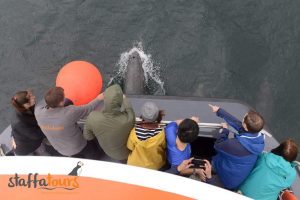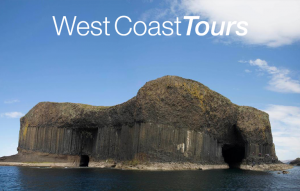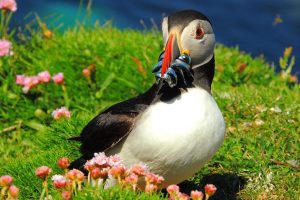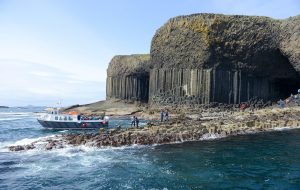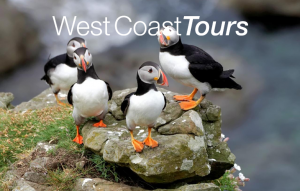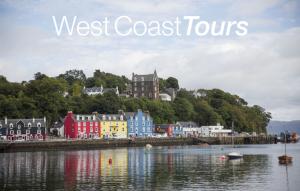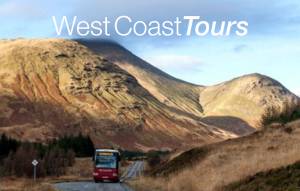Iona and its surrounds have an abundance of thriving wildlife due to a number of important reasons. The air and water quality is very high as there is little if no pollution or development making for the ideal wildlife environment.
Being a west coast island, Iona is a haven for birds, sea birds in particular. The shoreline and beaches provide the chance to spot oyster catchers, sandpipers, redshanks, plovers, curlews and grey lag geese. The endangered corncrake (Crex crex) also inhabits the iris beds near the machair. Raptors such as white tailed sea eagles, golden eagles, peregrine falcons, merlin and owls are also seen but less frequently.
Otters are sometimes spotted in the north of Iona, and down at the ferry on the Sound of Iona, dolphins, porpoises and seals can be seen rising above the surface. Even the occasional whale and basking shark have been seen swimming by.
Staffa & Fingals Cave Treshnish Wildlife Tour (Sails from August)
-
Departs:
Tobermory, Ardnamurchan
- 4 hours
£ 60
Staffa and Treshnish Isles Wildlife Tour from Fionnphort or Iona
-
Departs:
Iona, Fionnphort
- 6 hours
£ 85
ABOUT ISLE OF IONA
The Sound of Iona separates Iona from Mull and the visitor soon feels that the distance is much further, for Iona is more akin to the islands of the Outer Hebrides that it is to Mull. Low craggy hills overlook the narrow sandy beaches and small coves of the east coast. In the north and west the beaches are of dazzling shell sand, and the waves that break on them have a purity of colour unique to the Hebrides. The translucent atmosphere generally allows the outer island to be seen clearly, as well as the closer shore of Staffa, Ulva and Mull. The broad western beaches of Iona are backed by machair lands of rich pasture, another feature of the isles further to the west.
In the south the coastline is more rugged. At one point a fault in the cliffs shoots a spout of water hundred feet into the air if conditions are rough. At the southernmost tip of the island is the rocky inlet where St. Columba disembarked from his coracle.
HISTORY
Iona ABBEY
Iona’s most iconic landmark is undoubtedly Iona Abbey; one of the oldest and most important religious centres in Western Europe. Visitors come from all over the world on spiritual and religious pilgrimages to bathe in Iona’s spiritual atmosphere.
Built on the site of St Columba’s monastery, Iona Abbey was built by Viking Raghnall in 1200 AD as a centre for Benedictine worship. It fell into decline and ruin during the Reformation but was restored by Reverend George MacLeod and the newly formed Iona Community in 1938.
Many Scottish and European kings and chiefs are buried in the Abbey’s graveyard as is John Smith, late Leader of the Labour Party.
Visitors are welcomed all year round and can participate in daily worship led by the Iona Community.
The Nunnery is the first reminder of Iona’s long ecclesiastical history that the modern visitor to the island will encounter. Only a small community of nuns would have lived here, and the ruins are important in that they show so well how such a foundation was designed. The church is on the north side of a quadrangle, the centre of which served as a cloister. Opposite the church are the remains of the Refectory, while those of the Chapter House are on the east side. The buildings have been ruinous for nearly three hundred years though enough survives to make the Nunnery both romantic and interesting. The peace that the nuns must have enjoyed can still be appreciated in the lovely gardens of the cloister.
The Nunnery Museum is situated in St Ronan’s Chapel, just to the north of the ruined church. The Chapel has been re-roofed to house many of the interesting carved stones that were formerly scattered about the surrounding area. It was once the Parish Church of Iona and dates from about the same time as the Nunnery.
The first of the famous High Crosses of Iona stands opposite the Parish Church and Manse. This is MacLean’s Cross, which on its weathered western face has a portrayal of Christ Crucified. Its less weather-beaten east side is covered with an intricate Celtic design. It was commissioned by a member of the Clan MacLean in the latter part of the fifteenth century.
The Church and Manse date from 1828 when they were built to one of Telford’s ‘parliamentary’ designs. The architect, more famous for his roads and bridges than his churches, was commissioned by the government to provide several standard plans from which forty two new churches would be built in the Highlands and Islands.
Beyond the hotel is the Reilig Oran (the graveyard of Oran) the sacred burial place of the early Kings of Scotland, Ireland, and Norway. St. Oran, from which it takes its name was one of Columba’s followers who accompanied him to Iona.
A macabre legend tells how, when first landing on the island, Oran suggested that he should be buried alive as a living sacrifice to the island which would thus be sanctified. Columba accepted this idea and so Oran was buried. After three days the grave was opened up and Columba and his monks were horrified to find Oran still alive. As he spoke the words, ‘There is no such great wonder in death, nor is hell what it has been described’, Columba hastily ordered, ‘Earth, earth on Oran’s eyes, lest he further blab’, and so the unfortunate Oran was re-entombed.
With the re-establishment of a religious community on the island perhaps Columba’s famous prophecy is fulfilled:
Iona of my heart,
Iona of my love,
Instead of monks’ voices
Shall be the lowing of cattle;
But ere the world come to an end,
Iona shall be as it was.
Today this island offers us the rare chance of escaping from nearly all of the unwelcome trappings of the twenty first century. To a great many people it is the desert island of dreams come true, whether or not one is religious there is a spiritual peace to be found here, perhaps best reflected in the words of the composer Mendelssohn, after his visit to Iona in 1829:
…when in some future time I shall sit in a madly crowded assembly with music and dancing round me, and the wish arises to retire into the loneliest loneliness, I shall think of Iona…
WILDLIFE
THE SETTING
Iona is a tiny island – only three and a half miles long by one and a half across – separated from Mull by about a mile of water. Regular visitors to Iona travel through Mull by car or coach and cross the Sound of Iona by ferry from Fionnphort. The landing point is the pier just to the south of the Iona Abbey, at the foot of a hill that leads up the school. On the right is the village, its picturesque cottages overlooking the shore. There are only about seventy houses on the island, and nearly twenty of them are here.
Climbing the hill directly from the jetty the visitor soon encounters the first of Iona’s ruins – the remains of the Benedictine Nunnery founded in 1203 by Reginald MacDonald of Islay, Lord of the Isles. At the top of the hill there is a junction. Visitors to the cathedral turn right here, while those who have time to explore more of the island could take the other turning which leads to the south and Port a’ Churaich, the Port of the Coracle, where Saint Columba first set foot on the island and later established his now famous monastery.
Centuries before the arrival of St Columba on Iona in 563 the island had been adopted as a centre of religion by sun worshipping Druids. Like Columba, these priests of the Dark Ages must have sensed something unique in the atmosphere of Iona, a quality that still sets it apart as a spiritual oasis.
Perhaps it was the sparkling clarity of its light that appealed to these early mystics, for here the sky seems to open directly to Heaven not only as the sun goes down in comparable splendour, but throughout any sunny day when the cloud that hangs over the mainland and Mull miraculously breaks to bathe Iona in light that seems even brighter against the sombre unlit hills on the opposite shore.
Of course, it’s no use pretending that Iona escapes those days of unrelieved wetness that Western Scotland provides quite regularly, but it is true that Iona enjoys a substantial amount more sunshine than places to the east.
